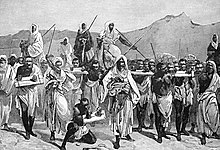Transformations of slavery in Africa
Slave relationships in Africa have been transformed through three large scale processes: the Arab slave trade, the Atlantic slave trade, and the slave emancipation policies and movements in the 20th century. Each of these processes significantly changed the forms, level, and economics of slavery in Africa.
Slave practices in Africa were used during different periods to justify specific forms of European engagement with the peoples of Africa. Eighteenth century writers in Europe claimed that slavery in Africa was quite brutal in order to justify the Atlantic slave trade. Later writers used similar arguments to justify intervention and eventual colonization by European powers to end slavery in Africa.
Africans knew of the harsh slavery that awaited slaves in the New World. Many elite Africans visited Europe on slave ships following the prevailing winds through the New World. One example of this occurred when Antonio Manuel, Kongo’s ambassador to the Vatican, went to Europe in 1604, stopping first in Bahia, Brazil, where he arranged to free a countryman who had been wrongfully enslaved. African monarchs also sent their children along these same slave routes to be educated in Europe, and thousands of former slaves eventually returned to settle Liberia and Sierra Leone.
Trans-Saharan and Indian Ocean trade
The Arab slave trade, established in the 8th and 9th centuries AD, involved a small-scale movement of people largely from the eastern Great Lakes region and the Sahel. Islamic law allowed slavery but prohibited slavery if it involved other pre-existing Muslims; as a result, the main target for slavery were the people who lived in the frontier areas of Islam in Africa. The trade of slaves across the Sahara and across the Indian Ocean also has a long history beginning with the control of sea routes by Afro-Arab traders in the ninth century. It is estimated that only a few thousand enslaved people were taken each year from the Red Sea and Indian Ocean coast. They were sold throughout the Middle East. This trade accelerated as superior ships led to more trade and greater demand for labour on plantations in the region. Eventually, tens of thousands per year were being taken. On the Swahili Coast, the Afro-Arab slavers captured Bantu peoples from the interior and brought them to the littoral. There, the slaves gradually assimilated in the rural areas, particularly on the Unguja and Pemba islands.
This changed the slave relationships by creating new forms of employment by slaves (as eunuchs to guard harems and in military units) and creating conditions for freedom (namely conversion—although it would only free a slave's children). Although the level of the trade remained small, the size of total slaves traded grew to a large number of the multiple centuries of its existence. Because of its small and gradual nature, the impact on slavery practices in communities that did not convert to Islam was relatively small. However, in the 1800s, the slave trade from Africa to the Islamic countries picked up significantly. When the European slave trade ended around the 1850s, the slave trade to the east picked up significantly only to be ended with European colonization of Africa around 1900.
In 1814, Swiss explorer Johann Burckhardt wrote of his travels in Egypt and Nubia, where he saw the practice of slave trading: "I frequently witnessed scenes of the most shameless indecency, which the traders, who were the principal actors, only laughed at. I may venture to state, that very few female slaves who have passed their tenth year, reach Egypt or Arabia in a state of virginity."
David Livingstone wrote of the slave trade: "To overdraw its evils is a simple impossibility ... We passed a slave woman shot or stabbed through the body and lying on the path. [Onlookers] said an Arab who passed early that morning had done it in anger at losing the price he had given for her, because she was unable to walk any longer. We passed a woman tied by the neck to a tree and dead ... We came upon a man dead from starvation ... The strangest disease I have seen in this country seems really to be broken heartedness, and it attacks free men who have been captured and made slaves." Livingstone estimated that 80,000 Africans died each year before ever reaching the slave markets of Zanzibar. Zanzibar was once East Africa's main slave-trading port, and under Omani Arabs in the 19th century as many as 50,000 slaves were passing through the city each year.





































No comments:
Post a Comment